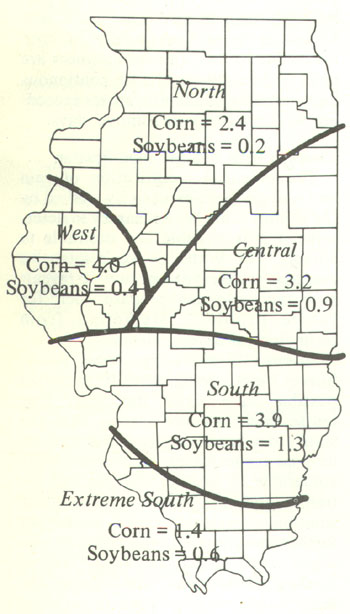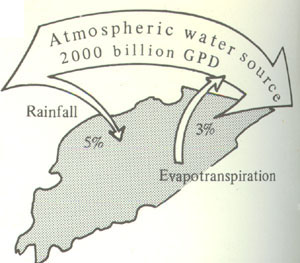
By STANLEY A. CHANGNON, JR.
Head of the Atmospheric Sciences Section of the Illinois State Water Survey, where he has been a research scientist for 20 years, Changnon is a Councilor and Fellow of the American Meteorological Society and president-elect of the Weather Modification Association.
Changing the weather:
Implications for Illinois
In a state where farming is a basic industry, people in the country watch the skies anxiously. The State Water Survey thinks something can be done about the weather. Illinois' model weather modification law is a basic step toward controlled experimentation
ILLINOIS weather can be changed—at least to some extent. Rainfall can be increased and hailstorms can be partially suppressed. A weather modification statute, proposed by the Illinois State Water Survey, has been in force for almost two years. The techniques of weather modification have not been completely refined, but as the General Assembly has officially stated, weather modification "is subject to regulation and control in the public interest."
Increased rainfall at the proper time and prevention of crop-damaging hail offer obvious benefits to farmers who raise corn, soybeans, and wheat. But the Illinois State Water Survey did not press for legislation until the staff had assessed the economic implications, ecological impacts, and social attitudes toward weather modification for the state generally. Legislation was deemed a prime requirement, not only for the proper execution of scientific experiments on weather modification in the state, but to protect Illinois citizens from improperly conducted weather modification operations.
The 78th General Assembly passed the Weather Modification Control Act (Illinois Revised Statutes, chapter 146 3/4) in 1973, placing administration of the law in the Department of Registration and Education, parent agency for the Water Survey. At the time the statute was enacted, neither Illinois nor the federal government had any legislation for this purpose. Thirty other states had laws of this sort on the books, but none are as comprehensive as the Illinois statute. The Illinois law is looked upon as a model for other states.
Illinois' remarkable climate
The implications of weather modification for midcontinental Illinois are as varied and complex as the state's weather. Illinois experiences an exceptional variety of weather types. Classic winter storms are followed by temperatures that frequently go below 0" Fahrenheit, and we lead the nation in the number of severe ice storms. In the spring oscillating warm and cold air masses cause very severe hailstorms and tornadoes. More people have been killed in Illinois by tornadoes in the past 60 years than in any other state, and Illinois is seventh nationally in crop losses due to hail. Illinois summers are near tropical, with almost continuous high humidity and temperatures exceeding 90°F on 20 to 40 summer days.
Concern with weather modification
The potential modification of rain and hail has been extensively studied by the Illinois State Water Survey to determine if it is possible and desirable in Illinois. The Water Survey's intensive research is relevant because it reveals how the state can prepare itself for future problems stemming from technological developments.
About 10 years ago, the Water Survey's meteorological staff reassessed possible state water shortages. This reassessment showed clearly that the state's developing agricultural and industrial technologies were increasingly vulnerable to weather changes and extremes. Weather modification was one solution considered, found worthy of further investigation, and research was begun with assistance from federal funding. Illinois has now become the leading Midwestern state in weather modification research and knowledge.
Before plunging into research on weather modification, Water Survey scientists investigated the effects of natural phenomena on the weather. These studies helped researchers determine how to investigate weather modification and climatic changes. For example, one study found that Lake Michigan greatly influences the frequency of rain, thunderstorms, and even
July 1975 / Illinois Issues / 195
Figure 1. Average annual crop increase (in bushels per acre) from 25% summer rain enhancement over 5 years

Figure 2. Atmospheric river over Illinois

hailstorms, particularly over the state of Michigan. Smaller lakes like those at Springfield and Decatur had no apparent effects on rainfall.
Another intensive study showed how the Shawnee Hill area in Southern Illinois increased summer precipitation over the hills by 10 to 15 per cent. The lifting of the air due to sharp bluffs, coupled with the greater moisture arising from the forests over the hills, were found to increase the hill rainfall. Such studies provided invaluable information in studying the causes and results of natural weather variations.
Active research into weather and climate modification in Illinois has also focused on changes caused accidentally by man through his cities and industrial activities. Survey scientists discovered that summer rainfall has increased by 20 to 30 per cent during the last 30 years over St. Louis and Chicago and an area extending 25 miles to the east of these cities. These increases were apparently due to a variety of urban-industrial effects on clouds (releases of heat, moisture, and tiny pollutant particles to form cloud droplets). The great concern over this led the Water Survey and other research groups, including the University of Chicago, to establish in 1971 an intensive field-oriented project in the St. Louis area called the Metropolitan Meteorological Experiment (METROMEX). Results have now clearly defined weather anomalies in two Illinois counties (Madison and St. Clair) which have, on the average, 20 per cent more summer rain, 25 per cent more thunderstorms, and 70 per cent more hailstorms than do all other surrounding areas. These anomalies have led to increases in local crop yields, increases in stream runoff, and decreases in water quality. The factors causing these anomalies are now under study. Knowledge of how man is accidentally altering rain and hail will greatly aid scientists in developing better ideas of how to purposely modify the weather in Illinois and elsewhere.
Another form of accidental weather modification under study by the survey is that caused by waste heat and moisture released from large power plants. The Water Survey has investigated the effects of existing cooling lakes and towers on Illinois weather. Results suggest that such waste products can generate local fog, icing, and even clouds and precipitation under certain conditions. Several of the very large power plants that are under construction in Illinois, as well as future coal gasification plants, will emit much greater amounts of heat and moisture than existing plants. Obviously, the environmental effects of these new types of energy installations must be carefully studied.
Sizeable economic benefits
Illinois has a "humid climate" and is often thought to have adequate rainfall. However, several studies have shown that in eight out of ten years crop yields would have benefited from morerain in July and August. Research to date does not indicate that weather modification could offer any real relief during the occasional severe summer droughts in Illinois, but in those summers of low to near-normal rainfall, agriculture could benefit from rain enhancement.
The average increase in corn and soybean yields with an increase in July-August rainfall is shown in Figure 1 for the entire state divided into five areas based on prevailing weather conditions. These figures are based on a 25 percent rain increase from a seeding operation performed during any possible five-year period. In each section of the state this increase in rainfall would result in an average yearly increase in both corn andsoybeans. In the south section the
196 / Illinois Issues / July 1975
Environmentalists, of course, want to know if there will be ecological changes if hail or rain is altered. An ecological . project by the State Natural History Survey involved a study of rabbits and their relationship to weather. It showed practically no relationship between rabbit populations and summer rainfall increases up to 25 per cent. These results, and those from other comparable studies, show that no significant ecological changes would occur by altering summer hail by 50 per cent or rain from 10 to 25 per cent.
Public attitudes on modification
The Illinois Water Survey and a group of Colorado sociologists also initiated a project in 1974 to sample 300 Central Illinois citizens, chosen at random, to gain information on the impact of weather on tneir lives and their attitudes towards weather modification. Such information is important in deciding how to design future modification experiments in Illinois so that they I will be accepted by the public. Basically. the altitudes of lllinoisans toward weather are similar to those of the citizens of' Colorado,Texas, Florida, and South Dakota.
A majority (54 per cent) of lllinoisans favored partial seeding of clouds in rain or hail suppression programs, as opposed to lull-scale seeding of all clouds. Fifty-five per cent believed that rain could be increased, but only 20 per cent thought hail could be decreased. In fact, 62 per cent admitted knowing nothing about hail suppression. With regard to decisions about the use of weather modification, nearly half (49 per cent) thought local residents should decide, but only 20 per cent believed that local residents would decide on a project. There also was a strong belief that the state, rather than the federal government, should and will decide on the use of weather modification in Illinois.
A major public concern with weather modification is whether seeding to increase rain at one location will affect rainfall elsewhere. An examination of the amount of precipitation well downwind of major cities (St. Louis and Chicago) does not reveal any "downwind" increase or decrease in rainfall. The concern that increasing rainfall in one place will cause a deficiency elsewhere is further refuted by the small amount of atmospheric water that falls as rain in Illinois. As shown in Figure 2, only five per cent of the enormous 2,000 billion gallons of moisture that passes over Illinois daily falls as rain. Moreover, 60 per cent of this (or three per cent of this "atmospheric river") returns to the air through evaporation from Illinois water bodies and plants. A 20 per cent increase in annual rainfall over the entire state would represent use of only one per cent of the atmospheric river, and more than half of this would be returned to the air by evaporative processes.
An analysis of weather modification laws in other states revealed the complex nature of this type of legislation, and a national expert in the field, Professor Ray J. Davis of the University of Arizona, was engaged to work with the Water Survey to draft a law. This draft was circulated among various interest groups which previously had been asked to take part in discussions of the benefits that might be expected from such a law.
House Bill 770 was introduced in March 1973 with Rep. R. Bruce, Waddell (R., Dundee) as chief sponsor and passed 144-0 on May 24. It passed 48-5 on June 2 in the Senate, where it was handled by Sen. Jack Schaffer (R., Crystal Lake) who represents Waddell's district in the Senate. Gov. Dan Walker signed it into law as Public Act 78-674 on September 10.
The law's objectives are to encourage weather modification operations, research and development, and to minimize possible adverse effects of such activities. It allows persons to be licensed by the Department of Registration and Education as weather modifiers and provides for permits to be issued for specific operations. A Weather Modification Board advises the department on rules and regulations. The board is composed of five persons with qualifications in agriculture, law, meteorology, and water resources. Members are appointed by the director of the Department of Registration and Education.¸
July 1975/Illinois Issues /197